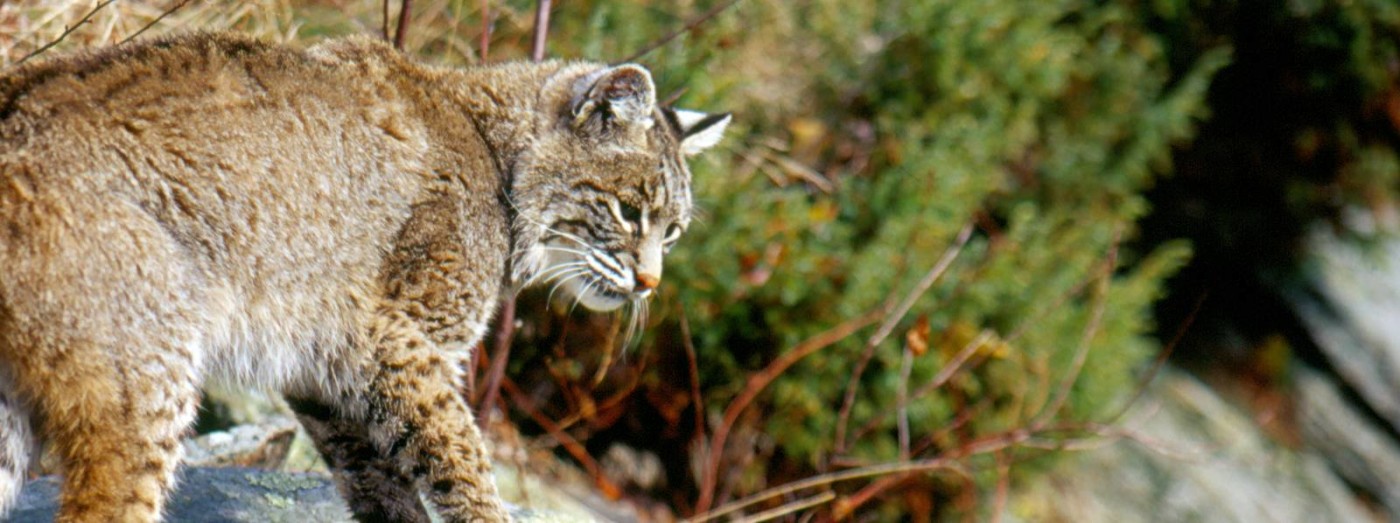Animals and Plants of the Finger Lakes
The Surprisingly Common Bobcat
Each year, the New York State Department of Environmental Conservation (DEC) receives many reports from people who think they have seen cougars or lynxes, both animals that are considered extinct in New York state.
Sometimes these mysterious animals turn out to be nothing more than house cats, fishers, or even dogs. If it really is a large wild cat, it’s almost certainly a bobcat (Lynx rufus). A recent rash of local media coverage — the animals have been spotted in Canandaigua and Lansing — might lead you to think that bobcats are rare in this area, or that they are recent arrivals. Although sightings of this secretive and solitary animal may be newsworthy, the animals themselves are fairly common. Unless you live in the middle of a city, chances are very good that a bobcat lives somewhere nearby.

The bobcat is a stocky animal about the size of a cocker spaniel and weighing twenty to thirty pounds. Its species name, rufus, is Latin for “red,” and in forested areas bobcats tend to be reddish-brown above, white below. (In drier climates, and in the winter, their coats are more grayish.) The bobcat’s fur is marked with black spots and bars, patterns that render it almost invisible on the sun-dappled forest floor. From a distance, the most obvious difference between the bobcat and a gigantic domestic cat is the former’s very short (“bobbed”) black-tipped tail. If you are fortunate enough to see the animal up close, you will notice a ruff of facial hair and large ears topped with black tufts that may act as antennae. Hind legs that are longer than the front legs give the bobcat more power when jumping, as well as a bobbing gait.
Historically, the bobcat was present in all lower forty-eight states, but its population was dramatically reduced in the intensely cultivated midwest and the heavily populated eastern seaboard. However, it seems to have made a remarkable comeback in recent years: currently, it is found in every state except Delaware. Despite the pressures of development and widespread hunting and trapping, most populations seem to be stable or increasing, and possibly even spreading.
This success story is attributable to several quirks of bobcat biology, as well as a few serendipitous events caused by human activity. The bobcat is a density-dependent breeder: the fewer cats there are, and the more food there is, the more litters will be born. Thirty-nine states, including New York, allow a bobcat harvest, but thanks to the animal’s reproductive habits, these harvests don’t seem to have put a dent in the population. Furthermore, the bobcat’s solitary nature means that populations are not as susceptible to communicable diseases as are social animals like the raccoon.
Unlike the lynx, which prefers the snowshoe hare, the bobcat will prey on everything from voles to small livestock. Bobcats are nothing if not enterprising: in the Adirondacks, a large part of the cat’s winter diet is made up of deer, including full-grown bucks that can be five or more times its size.
Bobcats are also successful because they are habitat generalists. They can live just about anywhere —from swamps to forests, desert to “urban edge”–– as long as there is sufficient cover for them to stalk their prey and raise their young. As Nathan Roberts, at the Cornell Department of Natural Resources, puts it: “All they need is a bush to hide behind, and a rabbit, and that’s bobcat habitat.” Over the last century, the abandonment of farms in upstate New York has created a patchwork of forest and farmland that is perfect for this little predator.
Interestingly, although humans have often made life hard for the bobcat, they may also have contributed to its success. Cougars compete with bobcats and may even kill them where their territories overlap, so the extirpation of the larger cat in the northeast may have benefited the smaller. Farming and logging in northeastern forests destroyed lynx habitat but created ideal conditions for the bobcat. Global climate change may turn out to be the greatest boon of all for the feline. Bobcats, unlike lynxes, are not suited to deep snow. If milder winters with less snow are in our future, it is likely that the bobcat will expand further north and into higher elevations, at the expense of its shyer and less adaptable northern cousin.
This story by Jacqueline Stuhmiller first appeared in our newsletter, The Land Steward, as part of the Closer Look series about plants and animals of the Finger Lakes region.





